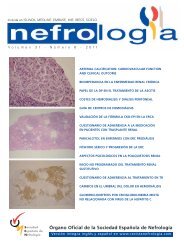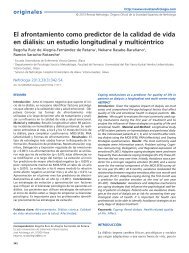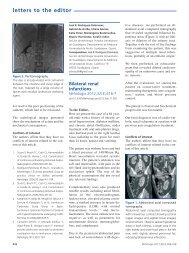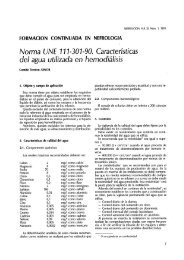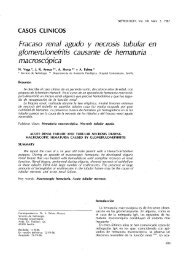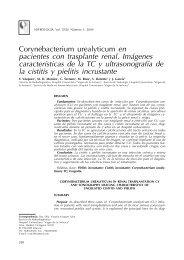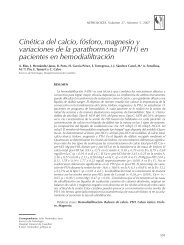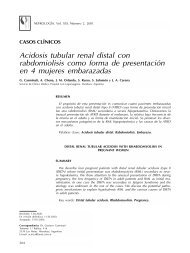PDF Número - NefrologÃa
PDF Número - NefrologÃa
PDF Número - NefrologÃa
Create successful ePaper yourself
Turn your PDF publications into a flip-book with our unique Google optimized e-Paper software.
Marco U. Martínez-Martínez et al. Renal function and SLE<br />
originales<br />
Table 3. Phase 1. Precision, bias, and accuracy<br />
Equation P30 Bias dIQR<br />
Rule 57.1 20.4407 61.4<br />
MacIsaac 50.0 7.4671 59.3<br />
Larsson 42.9 7.0065 63.6<br />
Stevens 78.6 -0.6402 42.1<br />
Stevens 2 42.9 9.6249 61.8<br />
Ma 57.1 -13.7871 46<br />
CKD-EPI 64.3 2.0918 25.4<br />
sMDRD 64.3 14.2569 24.8<br />
CG 64.3 -3.6681 42.4<br />
CGi 71.4 2.5279 31.3<br />
MCQ 71.4 1.3316 41.9<br />
CG: Cockcroft-Gault equation; CGi: Cockcroft-Gault equation (calculated with ideal weight); CKD-EPI: the Chronic Kidney Disease<br />
Epidemiology Collaboration equation; dIQR: Interquartile range; MCQ: Mayo Clinic Quadratic Equation; P30: Percentage of<br />
estimated GFR within 30% of mGFR; sMDRD: simplified MDRD study equation.<br />
using cystatin C in a patient with SLE (smoking,<br />
hypothyroidism, etc.), we looked for an equation based<br />
only on serum creatinine in which there is not the<br />
influence of these factors and our results were: the<br />
CKD-EPI equation should be used in patients with SLE.<br />
The importance of our results is that we do not need a<br />
24h urine collection to evaluate renal function in SLE<br />
patients as was done in several clinical trials. 33-35<br />
Moreover, CKD-EPI is more reliable than CrCl and the<br />
other equations, as our study describes. Rheumatologists<br />
can estimate renal function easily with the demographic<br />
data, standardized creatinine and with the help of<br />
internet or a smart phone (using CKD-EPI).<br />
There are several limitations to this analysis. First, the<br />
study population was composed only of Mexican<br />
patients; however, the main objective of the current<br />
work was to find the best available creatinine-based<br />
equation, and, in this way, our results can be<br />
generalized. Finally, these equations were not tested for<br />
assessment of change in GFR over time, but this is a<br />
diagnostic study in which we wanted to clarify the best<br />
equation and not the change over time.<br />
With our results, we suggest that the initial classification<br />
of patients with SLE should be with CKD-EPI, because<br />
of its reproducibility, ability to predict GFR in patients<br />
with low or high GFR, and ease of performance.<br />
Table 4. Phase 2. Precision, bias, and accuracy<br />
Equation P30 CI 95% Bias CI 95% dIQR CI 95%<br />
1. CKD-EPI 94.5 87.5, 100 -2.1 -4.4, 1.8 -2.1 -4.4, 1.8<br />
2. sMDRD 91.0 82.1, 98.2 4.2 1.4, 9.0 4.2 1.4, 9.0<br />
3. CG 75.1 64.3, 85.7 -12.2 -14.1, -5.5 -12.2 -14.1, -5.5<br />
4. CGi 87.5 78.6, 94.6 4.3 -1.2, 9.5 4.3 -1.2, 9.5<br />
5. MCQ 68.1 55.4, 80.4 -13.8 -17.6, -10.0 -13.8 -17.5, -10.0<br />
6. CrCl 80.4 69.6, 91.1 4.6 -0.3,19.0 4.6 -0.3, 19.0<br />
CG: Cockcroft-Gault equation; CGi: Cockcroft-Gault equation (calculated with ideal weight); CKD-EPI: the Chronic Kidney Disease<br />
Epidemiology Collaboration equation; CrCl: Creatinine clearance; dIQR: Interquartile range; MCQ: Mayo Clinic Quadratic Equation;<br />
P30: Percentage of estimated GFR within 30% of mGFR; sMDRD: simplified MDRD study equation.<br />
Nefrologia 2013;33(1):99-106<br />
103



